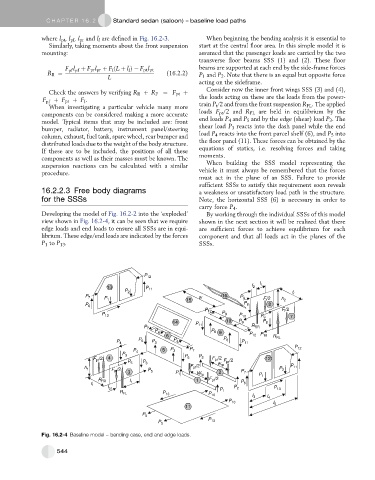Page 535 - Automotive Engineering Powertrain Chassis System and Vehicle Body
P. 535
CHAP TER 1 6. 2 Standard sedan (saloon) – baseline load paths
where l pt ,l pf ,l pr and l l are defined in Fig. 16.2-3. When beginning the bending analysis it is essential to
Similarly, taking moments about the front suspension start at the central floor area. In this simple model it is
mounting: assumed that the passenger loads are carried by the two
transverse floor beams SSS (1) and (2). These floor
beams are supported at each end by the side-frame forces
F l þ F pr l pr þ F ðL þ l Þ F pt l pt
pf pf
l
l
R R ¼ (16.2.2) P 1 and P 2 . Note that there is an equal but opposite force
L
acting on the sideframe.
Consider now the inner front wings SSS (3) and (4),
Check the answers by verifying R R þ R F ¼ F pt þ
F pf þ F pr þ F : the loads acting on these are the loads from the power-
l
When investigating a particular vehicle many more train P t /2 and from the front suspension R FL . The applied
components can be considered making a more accurate loads F pt /2 and R FL are held in equilibrium by the
model. Typical items that may be included are: front end loads P 4 and P 5 and by the edge (shear) load P 3 . The
bumper, radiator, battery, instrument panel/steering shear load P 3 reacts into the dash panel while the end
column, exhaust, fuel tank, spare wheel, rear bumper and load P 4 reacts into the front parcel shelf (6), and P 5 into
distributed loads due to the weight of the body structure. the floor panel (11). These forces can be obtained by the
If these are to be included, the positions of all these equations of statics, i.e. resolving forces and taking
components as well as their masses must be known. The moments.
suspension reactions can be calculated with a similar When building the SSS model representing the
procedure. vehicle it must always be remembered that the forces
must act in the plane of an SSS. Failure to provide
sufficient SSSs to satisfy this requirement soon reveals
16.2.2.3 Free body diagrams a weakness or unsatisfactory load path in the structure.
for the SSSs Note, the horizontal SSS (6) is necessary in order to
carry force P 4 .
Developing the model of Fig. 16.2-2 into the ‘exploded’ By working through the individual SSSs of this model
view shown in Fig. 16.2-4, it can be seen that we require shown in the next section it will be realized that there
edge loads and end loads to ensure all SSSs are in equi- are sufficient forces to achieve equilibrium for each
librium. These edge/end loads are indicated by the forces component and that all loads act in the planes of the
P 1 to P 13 . SSSs.
P 12
I l
13 P 11 I 2
P 2
t r
P 7 w 16 P 9 F l /2
P 1
15 h 2
P 8 8
P 6
F l /2
P 12
P 9
P 13 P 10
P 9 7
14 P 11 10 P 9 P 8
R RR
P 7
P 4 P 8 9
6 P 12 P 10 R RL
P 6 P 4 P 8
P 4 P 3 P 11
P 12
5 P 3 P 7
P 4
P 3
F pt /2 4 P 6 P 2 F pr /2 F pr /2 12
P 5 P 3
F pf /2 w rp P 11
h 1
F pt /2 P 2
3 P 5 P 1 2 P 7
W fp
P 1
R FR I 1 1 F pf /2
P 6
t f
I pt P 2 P 13
P 1
R FL P 13 P 10
I 3
I 4
P 10
I 5
11
P 5
P 13
P 5
Fig. 16.2-4 Baseline model – bending case, end and edge loads.
544

